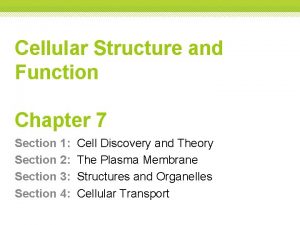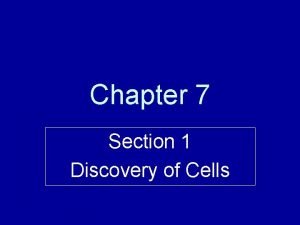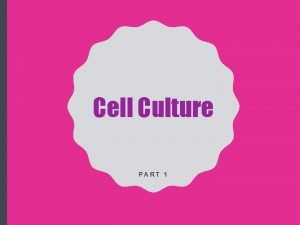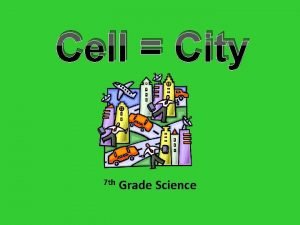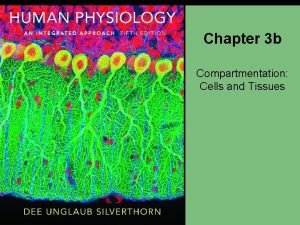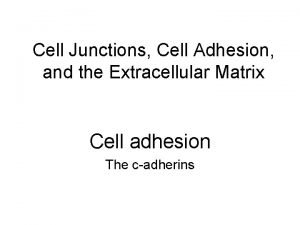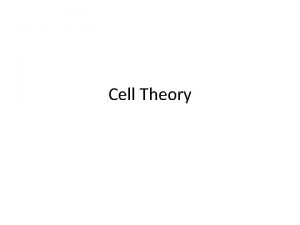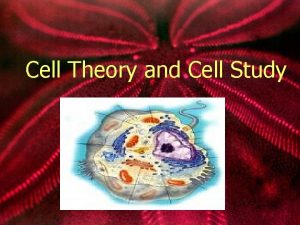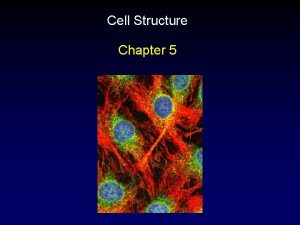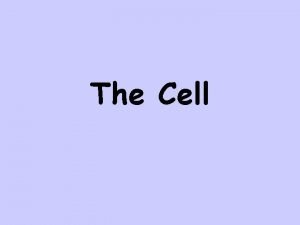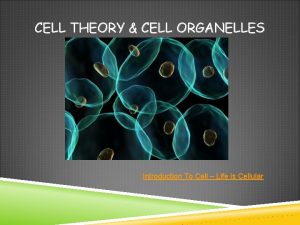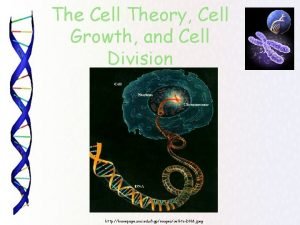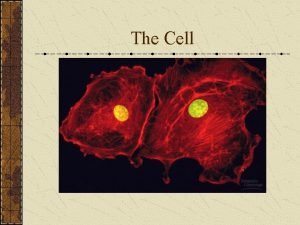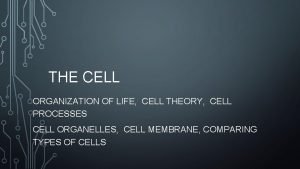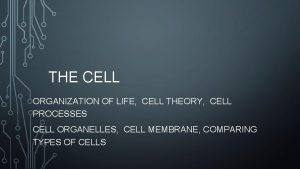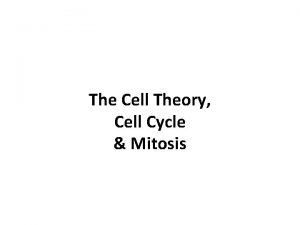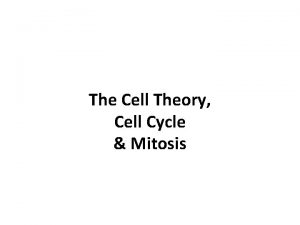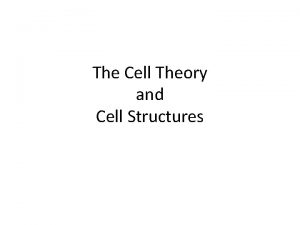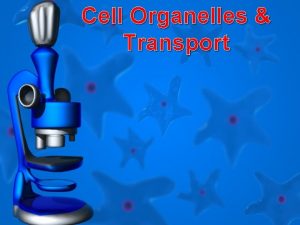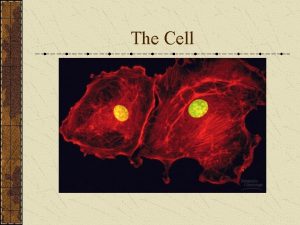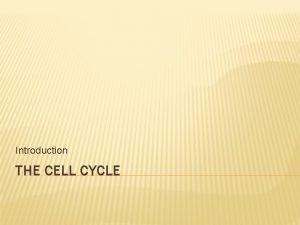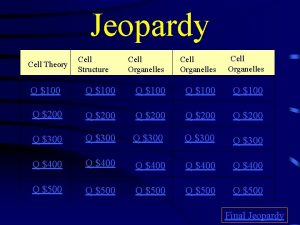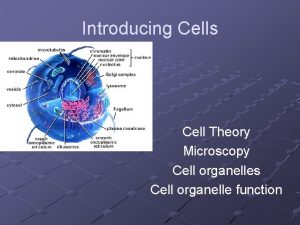Chapter 7 Explain the cell theory Name the































- Slides: 31

Chapter 7 Explain the cell theory. Name the basic cell structures. Describe prokaryotes and eukaryotes.


What is the Cell Theory? Widely accepted explanation of the relationship between cells and living things. The cell theory states the following: • All living things are composed of cells. • Cells are the basic unit of structure and function in living things. • All cells are produced from other cells.

Robert Hooke “Cells are the basic unit of structure and function in living things” • In 1665, Hooke looked at a thin slice of cork through one of the first light microscopes. • Hooke described the cork as being made of thousands of tiny chambers. • Hooke called these chambers “cells” because they reminded him of the monastery’s tiny rooms which were called cells.

All living things are composed of cells Matthias Schleiden • Concluded that all plants were made of cells Theodor Schwann • Concluded that all animals were made of cells

Rudolf Virchow “New cells are produced from existing cells” • Studied cell reproduction

Cell Types Prokaryotes Eukaryotes • Organisms who’s cells LACK nuclei. • REMEMBER: Pro has no nucleus • Organisms whose cells have nuclei (more advanced) • REMEMBER: Eu do have a nucleus

Cell Structures and functions

Cell membrane • Function – controls what enters and exits the cell; also provides protection and support for the cell. • Structure – phospholipid bilayer (two layers of phospholipids with carbohydrate chains and protein channels). Selectively permeable barrier. • Found in all cells • Similar to the gates of a gated community, or a fence

Cell wall • Structure – rigid structure made up mostly of cellulose fibers • Function – to provide support and protection for the cell. • Found only in plant, bacteria, and fungi cells • Similar to gates of a gated community/fence

Nucleus • Structure – has a nucleolus (where the making of proteins begins), chromatin (grainy mixture of DNA and protein), chromosomes (condensed chromatin) and nuclear envelope • Function – controls most cell processes and contains the hereditary material DNA • Found in eukaryotic cells, plant and animal cells • Similar to the boss, city hall, library

Cytoplasm • Structure – clear, thick, jellylike material inside the cell. Contains cytoskeleton fibers (microtubules and microfilaments) • Function – supports, protects, and helps transport organelles inside the cell • Found in all cells • Similar to the interstates, highways, roads, and the support beams in buildings

Ribosomes • Structure – small bodies free or attached to ER and made of protein and r. RNA • Function – synthesizes (assembles or makes) proteins • Found in all cells • Similar to a construction site

Endoplasmic Reticulum • Structure – network of tubes or membranes; connected to nuclear envelope and cell membrane (rough has ribosomes/smooth doesn’t) • Function – carries materials through cell and aids in making proteins, parts of the cell membrane. • Found in all eukaryotic cells • Similar to a factory

Golgi Apparatus • Structure – stacks of flattened sacs • Function – package and export proteins, modify proteins (attaches carbohydrates and lipids to proteins) made by the cells in the ER. • Found in all eukaryotic cells • Similar to a shipping company (UPS/Post Office)

Vacuoles • Structure – fluid-filled sacs (the largest organelle in a plant cell) • Function - store food, water, and waste • Found in eukaryotic cells; plant cells have one large vacuole and animal cells have multiple small vacuoles. • Similar to storage company or water tower

Chloroplasts • Structure – green, oval containing chlorophyll; double membrane with inner membrane modified into sacs • Function – uses solar energy to make food (glucose) and release oxygen. • Found in plants and algae • Similar to solar energy panels

Mitochondria • Structure – peanut shaped, double membrane (outer is smooth and inner is folded) • Function – breaks down glucose (food) molecules to release energy • Found in all eukaryotic cells • Similar to MLGW or other similar power company

Nuclear envelope • Structure – flexible, selectively permeable, double membrane • Function – controls movement of materials in/out of nucleus • Found in all eukaryotic cells • Similar to a gate/door

Lysosome • Structure – small, round organelle with a single membrane • Function – digests old cell parts; breaks down larger molecules into smaller molecules • Found mostly in animal cells and only occasionally in plant cells • Similar to a garbage/recycling company

Centrioles • Structure - a cylinder of microtubule pairs; found in pairs near the nucleus • Function – separates chromosome pairs during cell division • Found only in animal cells

Lowest Level Highest Level

Transportation through the Cell Membrane Active transport moves substance against the concentration gradient (from low concentration to high concentration) Passive transport moves substances with the concentration gradient (from high concentration to low)

The Cell Membrane What are the main functions of the cell membrane? It regulates what enters and leaves the cell and provides protection and support What does it mean that a cell membrane has a “lipid bilayer”? It is composed of two “bi” layers of lipid molecules with protein molecules that help certain substances to enter or exit the cell. It also has carbohydrates that behave as identity markers (name tags).

What does it mean when a membrane is selectively permeable? • The membrane will allow only certain materials to pass across the membrane.

Diffusion • Diffusion is the movement of molecules from an area of high concentration (where there are many) to an area of low concentration (where there are few). • This is a type of Passive transport since it does not require the input of additional energy.

Osmosis • Osmosis is the diffusion of water molecules through a permeable membrane from an area of high concentration to an area of low concentration. • Because it is the diffusion of water, it is also a type of passive transport.

Facilitated Diffusion • During facilitated diffusion, the protein channels in the cell membrane help (facilitate) certain molecules like glucose (which can not simply diffuse) to pass through those protein channels into or out of the cell. • Again, this is a type of diffusion, so it is also a type of passive transport (the movement of molecules is from areas of high concentration to low concentration)

Equilibrium • When is equilibrium reached in a solution? – When the concentration of the solute is the same on both sides of the cell membrane or throughout a solution

Endocytosis • Endocytosis is the process of taking material into the cell by enfolding of the cell membrane around large molecules, clumps of food, or even whole cells. • This is a type of active transport because it requires the input of additional energy and the substance is moving against the concentration gradient (from an area of low concentration to high concentration).

Exocytosis • During exocytosis, the membrane of the vacuole surrounding the material fuses with the cell membrane, forcing the contents out of the cell. • Because this type of transport requires the cell to use energy and the substance is moving against the concentration gradient, exocytosis is a type of active transport.
 The scientist mathias schleiden studied _______ in ______.
The scientist mathias schleiden studied _______ in ______. Name all rays
Name all rays Chapter 7 section 1 cell discovery and theory
Chapter 7 section 1 cell discovery and theory Chapter 7 section 1 cell discovery and theory
Chapter 7 section 1 cell discovery and theory Cell city analogy project
Cell city analogy project Advantages of diaphragm cell
Advantages of diaphragm cell Site:slidetodoc.com
Site:slidetodoc.com Prokaryotic cell and eukaryotic cell similarities
Prokaryotic cell and eukaryotic cell similarities Venn diagram of plant and animal cell
Venn diagram of plant and animal cell Spontaneity of redox reactions
Spontaneity of redox reactions Dry cell vs wet cell
Dry cell vs wet cell Comparing plant and animal cells venn diagram
Comparing plant and animal cells venn diagram Function of the cell wall
Function of the cell wall Plant cell structure
Plant cell structure Plant cell parts and functions
Plant cell parts and functions Cell wall vs cell membrane
Cell wall vs cell membrane Cell strain
Cell strain Finite and continuous cell lines
Finite and continuous cell lines Cell city project
Cell city project Primary voltaic cell
Primary voltaic cell Difference between bacteria and plant cell
Difference between bacteria and plant cell Cell-cell junction
Cell-cell junction Cell-cell junction
Cell-cell junction What cell organelle is like lysol spray cleaning the cell
What cell organelle is like lysol spray cleaning the cell Cell cycle and cell division
Cell cycle and cell division Life
Life Eukaryotic cell animal cell
Eukaryotic cell animal cell Parts of a cell graphic organizer
Parts of a cell graphic organizer Idealized animal cell and plant cell
Idealized animal cell and plant cell Walker cell and hadley cell
Walker cell and hadley cell Prokaryotic vs eukaryotic transcription worksheet
Prokaryotic vs eukaryotic transcription worksheet Cell cycle and cell division
Cell cycle and cell division


